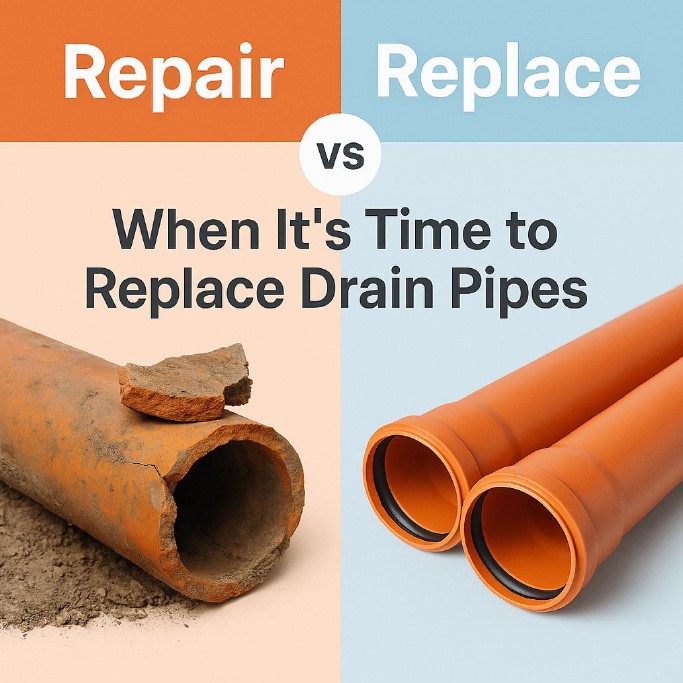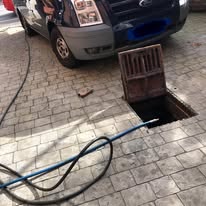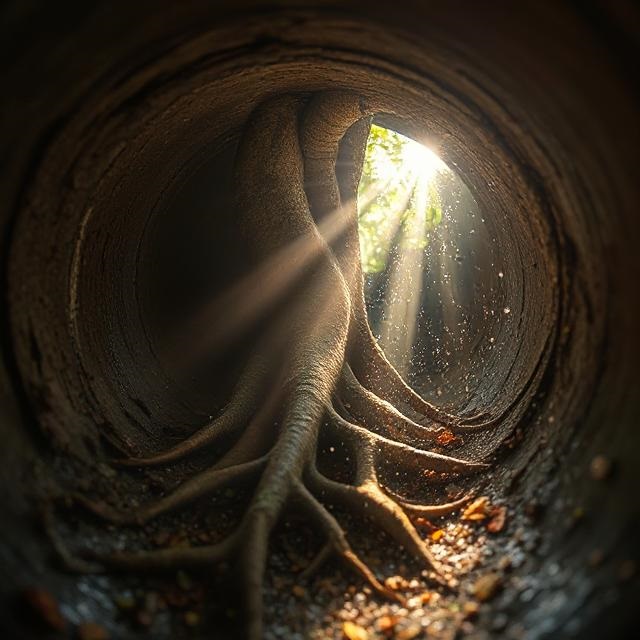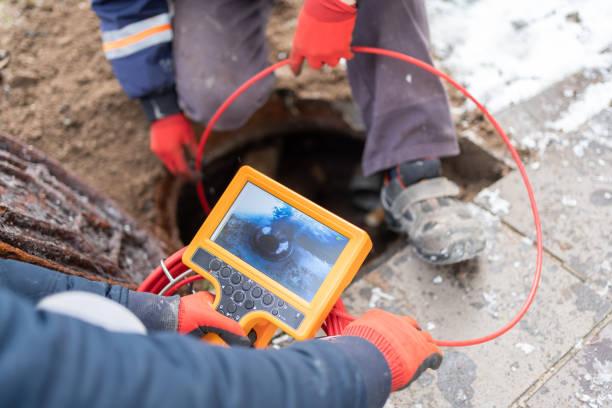
18
Aug 2025
Repair vs Replace: When It's Time to Replace Drain Pipes
Drainage systems are often taken for granted until something goes wrong. In London and across the UK, many properties from Victorian terraced houses to modern apartments rely on underground drain pipes that have been in place for decades. Over time, wear and tear, root intrusion, and even ground movement can compromise these pipes.
For homeowners, landlords, and property managers, the big question is this: should a damaged drain pipe be repaired, or is full replacement the wiser choice? Understanding the difference can save both money and stress in the long run.
Why Drain Pipes Fail
Drain pipes are designed to last for decades, but they are not immune to problems. Common causes of failure include:
- Ageing infrastructure – Many London properties still rely on Victorian-era drains made of clay, which can crack, collapse, or shift over time.
- Tree root intrusion – Roots naturally seek out moisture and nutrients, often breaking into joints and small cracks in underground pipes.
- Ground movement & subsidence – Shifting soil or heavy traffic above can misalign or crush pipes.
- Blockages and build-ups – Grease, fat, scale, and debris can cause pressure that eventually damages the pipe's structure.
- Corrosion – Older metal pipes may corrode, leading to leaks and weakened walls.
Recognising the cause of the damage is the first step toward deciding whether repair or replacement is appropriate.


Signs That Repair May Be Enough
In many cases, a drain pipe does not need full replacement. Minor issues can often be fixed using modern techniques that require minimal digging.
1. Localised Cracks or Fractures
If only a short section of pipe is cracked, engineers can apply patch repairs. This involves inserting a resin-soaked liner that seals the damaged section.
2. Small Root Intrusions
When tree roots have entered the drain but not caused major displacement, root cutting and relining may restore full functionality.
3. Minor Leaks
Seepage from small joints or connections can often be sealed without replacing the entire pipe system.
4. Build-Up and Blockages
If the main issue is a build-up of fat, oil, or debris, high-pressure jetting followed by relining may be a cost-effective solution.
In these scenarios, repairs are usually quicker, cheaper, and less disruptive than full replacement.
When Replacement Is the Only Option
Unfortunately, there are situations where repairs simply won't hold. Full pipe replacement is generally required when:
1. Collapsed or Severely Damaged Pipes
Once a drain pipe collapses, wastewater cannot flow. No-dig methods won't work — excavation and replacement are unavoidable.
2. Extensive Corrosion
Metal pipes, especially older cast iron ones, eventually deteriorate to a point where patch repairs are futile.
3. Repeated Failures
If a pipe requires multiple repairs within a short period, replacement is more cost-effective in the long term.
4. Major Misalignment
Ground movement or subsidence may shift pipes so far out of place that water cannot flow, leaving replacement as the only viable solution.
5. Old and Unfit Materials
Victorian clay pipes or pitch-fibre pipes installed in the mid-20th century often deteriorate beyond repair. Replacement ensures a stronger, longer-lasting solution.
Methods of Drain Repair and Replacement
Understanding the techniques available can help property owners make informed choices.
Trenchless Repair (No-Dig)
Modern trenchless methods such as drain relining or patch lining can restore the interior of pipes without excavation. This is less disruptive and often cheaper than digging.
Partial Excavation
When only a small section is damaged, engineers may excavate and replace a short length, leaving the rest of the system intact.
Full Excavation and Replacement
In severe cases, the only solution is to dig up and replace the entire drainage run. Though disruptive, this guarantees long-term peace of mind.
Drain Pipe Repair vs Replacement: Pros and Cons
| Factor | Repair | Replacement |
|---|---|---|
| Cost | Lower upfront | Higher upfront |
| Disruption | Minimal (no-dig methods) | High (excavation needed) |
| Longevity | 5–20 years depending on method | 50+ years |
| Suitability | Minor / localised damage | Severe / widespread damage |
| Eco-impact | Less waste, sustainable | More materials used |
Case Studies from London Homes
- Victorian Terrace in Hackney – A collapsed clay pipe under the garden required full replacement after repeated blockages.
- Modern Flat in Croydon – Root ingress sealed with trenchless relining, saving time and avoiding excavation.
- School in Bexleyheath – A combination of patch repairs and partial excavation addressed both cracks and collapsed joints.
These examples show that the decision is highly situation-dependent.
Preventing Future Drain Problems
Whether repairing or replacing, property owners can take steps to extend the life of their drains:
- Avoid flushing wet wipes, fats, and oils.
- Regularly clean gutters and gullies to prevent debris build-up.
- Schedule CCTV drain surveys to catch small issues early.
- Consider eco-friendly landscaping (permeable paving, soakaways) to reduce strain on systems.
Key Takeaway
Deciding between drain pipe repair and replacement requires a careful balance of cost, disruption, and long-term value. Minor cracks, leaks, and blockages can often be fixed with no-dig repairs, but collapsed or severely damaged pipes will eventually require full replacement.
Expert Drain Assessment by Marcel & Son
For property owners in London, a CCTV drain survey is the most reliable way to assess the condition of underground pipes and make an informed choice.
Marcel & Son, established in 1990, are a family-run business providing CCTV drain surveys in Bexleyheath and blocked drain repairs across London. With decades of experience and a 24/7 response team, they can help homeowners, landlords, and businesses decide when repair is enough and when replacement is the safer, long-term solution.
Frequently Asked Questions
How do I know if my drain pipe needs repair or replacement?
Minor cracks, blockages, and small root intrusions often only need repair — but collapsed or severely corroded pipes usually require replacement.
Is pipe relining better than replacing drain pipes?
Pipe relining is a trenchless, cost-effective solution for minor to moderate damage. Replacement is necessary if the pipe has collapsed, shifted, or is beyond repair.
How much does it cost to repair or replace a drain pipe in London?
Repairs can cost a few hundred pounds, while partial or full replacement may run into several thousand depending on damage, access, and property type.
Can CCTV surveys tell me if I need to replace a drain pipe?
Yes, CCTV drain surveys provide a detailed view of cracks, collapses, or misalignment, helping determine if a simple repair is enough or if replacement is necessary.
What type of pipes are most common in London homes?
Many older properties still have clay or cast iron pipes, both prone to cracking or corrosion. Modern replacements use plastic pipes, which are more durable and resistant.
Categories
Drain Repairs
Pipe Replacement
CCTV Drain Surveys
Property Maintenance
Related Services
Recent Posts
Repair or Replace?
Get expert advice on whether your drains need repair or replacement. Professional assessment available.
Call Us Today


